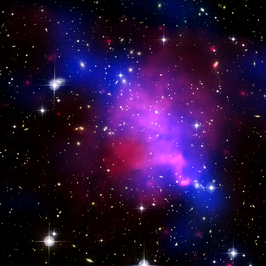
Abell 520
Encyclopedia

Galaxy cluster
A galaxy cluster is a compact cluster of galaxies. Basic difference between a galaxy group and a galaxy cluster is that there are many more galaxies in a cluster than in a group. Also, galaxies in a cluster are more compact and have higher velocity dispersion. One of the key features of cluster is...
is an unusual structure resulting from a major merger. It has been popularly nicknamed The Train Wreck Cluster, due to its chaotic structure.
This particular cluster presents a major problem for prevailing theories about Dark Matter
Dark matter
In astronomy and cosmology, dark matter is matter that neither emits nor scatters light or other electromagnetic radiation, and so cannot be directly detected via optical or radio astronomy...
as well as most alternative theories of modified gravity, because its dark matter content does not appear to behave as expected like in other clusters. As expected, the cluster's galaxies and intergalactic gas content are separated, much like the well-known Bullet Cluster
Bullet cluster
The Bullet cluster consists of two colliding clusters of galaxies. Studies of the Bullet cluster, announced in August 2006, provide the best evidence to date for the existence of dark matter...
and other merging clusters. It also appears to have as many galaxies and as much intergalactic gas as is expected for a cluster of this size. However, it has a large gravitational lensing core (usually thought to be the location of the dark matter) that appears to be devoid of galaxies or other normal matter. Prevailing theories of Dark Matter believe that dark matter must always stay closely attached to the galaxies. Meanwhile, the prevailing theories also believe that only the intergalactic gas is free to separate out from both the galaxies and the dark matter, during mergers. Here, the dark core appears to have little or no correlation to any of the cluster's other components. It has not yet been determined how the dark matter and galaxies were separated.
External links
- Universe Today, Galaxy Cluster Collision Creates a Dark Matter Core

